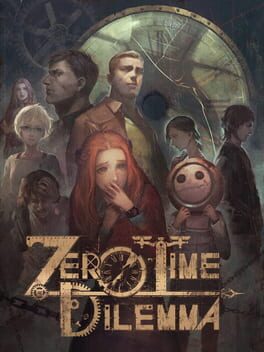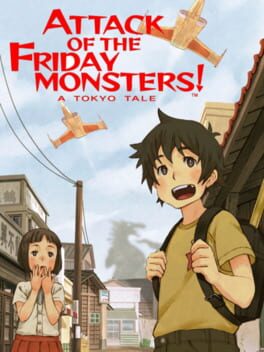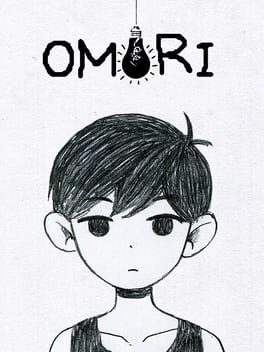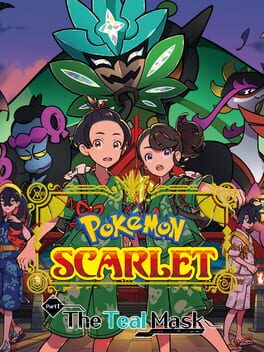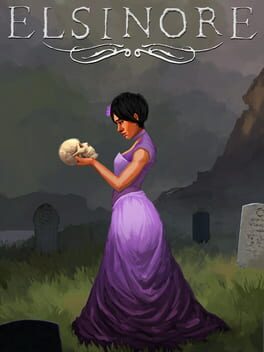wingXblade
47 reviews liked by wingXblade
A mess of a trilogy closer, downgraded on every front from its progenitors, unable to meet its high ambitions. It's not without merit, but it's extremely hit or miss. Its approach to chronologically ambiguous storytelling is maybe its only unmarred highlight. Its character beats, puzzles, and twists (of which there are many) peak at "not as well done in the previous two games" and bottom out unfathomably low.
Its attempt to tell a much more harrowing tale than the previous two games is seriously undercut by its mawkish writing, awkward character animations, and stiff voice acting (which reeks of poor direction, not a slight on the VA's talent). Because of these, it often ends up as a farce - comic when it grasps for tragedy, and something to laugh at when it asks the player to laugh with it.
I held hope that Zero Time Dilemma would reward enduring until the end. I wanted to know how ZTD would try to justify the time spent playing it. Unfortunately, that desire was left unfulfilled. No puzzle left a deep, lasting sense of satisfaction. No character development or plot arc gave any kind of meaningful insight. No twist or mystery electrified my mind racing with excitement or fascination. All that it left was a beleaguered shrug of exhaustion: "Well, I guess that happened."
Life is simply unfair, don't you think?
Its attempt to tell a much more harrowing tale than the previous two games is seriously undercut by its mawkish writing, awkward character animations, and stiff voice acting (which reeks of poor direction, not a slight on the VA's talent). Because of these, it often ends up as a farce - comic when it grasps for tragedy, and something to laugh at when it asks the player to laugh with it.
I held hope that Zero Time Dilemma would reward enduring until the end. I wanted to know how ZTD would try to justify the time spent playing it. Unfortunately, that desire was left unfulfilled. No puzzle left a deep, lasting sense of satisfaction. No character development or plot arc gave any kind of meaningful insight. No twist or mystery electrified my mind racing with excitement or fascination. All that it left was a beleaguered shrug of exhaustion: "Well, I guess that happened."
Life is simply unfair, don't you think?
24 Killers
2023
mannnn. 24 killers may just be my favourite thing ive played this year so far. and you wouldnt guess it at a superficial glance - it looks fairly quaint if you dont try it for yourself. "a moon rpg clone, a love-de-lic-like"... when people try to capture a game like that, the pigeonholing of it kind of covers up all nuance in a homogenising white paint, huh?
but 24 killers is absolutely not its inspirations - not exclusively. what 24 killers does better than every single other game ive seen (even ones ive spent more time with!) is flavour. everything oozes charme, everyone has personality to spare. its language is almost like a bit of a code - "man" (the interjection) becomes "mon"; "fuck" becomes "foam"; "garbage" is always gabbage. its remarkably consistent, and the grooves of its writing arent disturbing, but familiar and warm.
it is also truly a kind game - kind on your patience, and your time, and your care. it isnt wasteful; when it asks you to wait, it knows you have that moment to spare. its like a long-lost friend that you hit it right back off on your first meeting in ages.
more than any other game ive played in recent years, 24 killers has made me smile wide and giggle adoringly at a funny turn of phrase, or an imaginative design, or a silly character.
yes, it feels sometimes like its held together with duct tape, and some small visual polishes are missing - but rather than take away from it, they betray a humanity, the hands that touched its creation.
i remember when its demo hit during a steam next fest that the developer played it with his son; and even though its a game where people smoke (the moon does, too!) and kalashnikovs are strewn about the place, it feels like it really does suit both the grown-up developer to play it, AND his kid, and anyone at the ages in-between.
thank you, happy shabby games. not shabby at all - youve made me very happy with your little island; it really feels like home.
but 24 killers is absolutely not its inspirations - not exclusively. what 24 killers does better than every single other game ive seen (even ones ive spent more time with!) is flavour. everything oozes charme, everyone has personality to spare. its language is almost like a bit of a code - "man" (the interjection) becomes "mon"; "fuck" becomes "foam"; "garbage" is always gabbage. its remarkably consistent, and the grooves of its writing arent disturbing, but familiar and warm.
it is also truly a kind game - kind on your patience, and your time, and your care. it isnt wasteful; when it asks you to wait, it knows you have that moment to spare. its like a long-lost friend that you hit it right back off on your first meeting in ages.
more than any other game ive played in recent years, 24 killers has made me smile wide and giggle adoringly at a funny turn of phrase, or an imaginative design, or a silly character.
yes, it feels sometimes like its held together with duct tape, and some small visual polishes are missing - but rather than take away from it, they betray a humanity, the hands that touched its creation.
i remember when its demo hit during a steam next fest that the developer played it with his son; and even though its a game where people smoke (the moon does, too!) and kalashnikovs are strewn about the place, it feels like it really does suit both the grown-up developer to play it, AND his kid, and anyone at the ages in-between.
thank you, happy shabby games. not shabby at all - youve made me very happy with your little island; it really feels like home.
This review contains spoilers
Dragon Quest IV is my second favorite DQ game. Hearing that Psaro the main villain of the game was getting his own game, I was beyond excited.
The story is absolutely awful. Its a non cannon alternate take on DQ4, that doesn't understand the original's brilliance. Psaro should have had dialogue. Instead we get an awful yes and no feature that fails at every turn.
This game should have had you defeat Randolfo the Tyrant then have it end with Rose being killed, setting up the chosen's quest to revive her and save both her and Psaro. Instead Toilen Trouble uses time sand to show Psaro the future, so they save Rose and Psaro looses his redemption.
but i guess i got to use Calasmos, cool
The story is absolutely awful. Its a non cannon alternate take on DQ4, that doesn't understand the original's brilliance. Psaro should have had dialogue. Instead we get an awful yes and no feature that fails at every turn.
This game should have had you defeat Randolfo the Tyrant then have it end with Rose being killed, setting up the chosen's quest to revive her and save both her and Psaro. Instead Toilen Trouble uses time sand to show Psaro the future, so they save Rose and Psaro looses his redemption.
but i guess i got to use Calasmos, cool
I've never seen a modern 3D rpg replicate so perfectly the vibes of, like, random mid-tier Game Boy rpgs like Robopon or Legend of The River King. From the extremely abstracted, yet somehow small and isolated, environments, to the wordy yet breezy and somewhat hollow structure of the game itself, which mainly exists just to prop up the excellent monster battler mechanics. All those are vibes that I thought were lost to time, and seeing them resurface here put a nostalgic smile on my face.
To be fair, this stuff can either be good or bad depending on your tastes. It can maybe come off as cheap in what's supposed to be a "modern 3d game for grown ups". But, like, it is definitely a very Distinct vibe, and you gotta at least respect it for that.
I didn't really want to stick with it for 40 hours. Which is also true of a lot of those mid-tier game boy rpgs it reminds me of. But what I've played I enjoyed thoroughly. Which is also true of a lot of those mid-tier game boy rpgs it reminds me of.
To be fair, this stuff can either be good or bad depending on your tastes. It can maybe come off as cheap in what's supposed to be a "modern 3d game for grown ups". But, like, it is definitely a very Distinct vibe, and you gotta at least respect it for that.
I didn't really want to stick with it for 40 hours. Which is also true of a lot of those mid-tier game boy rpgs it reminds me of. But what I've played I enjoyed thoroughly. Which is also true of a lot of those mid-tier game boy rpgs it reminds me of.
Pokémon Omega Ruby
2014
It's hard to know how to evaluate Pokemon Omega Ruby. It is the eleventh game in the world's most profitable franchise. It is a 2014 remake of a 2002 game. And it is a turn-of-the-century environmental narrative in a time of massive environmental upheaval. Each provides a different view on the conservative approach taken to create Omega Ruby.
Omega Ruby the 11th Iteration
As a series that is constantly (yet conservatively) iterating on its formula, Omega Ruby makes valuable refinements broadly focused on saving the player time. The DexNav eases Pokedex completion, in addition to making typically rare/inaccessible egg moves & hidden abilities available. A lategame key item makes quickly traveling across Hoenn fast & easy (while also opening up a few extra locations). The Mega Evolution mechanic is also better paced than X & Y, with a constant drip feed of new Mega Evolutions made available instead of saving nearly all of them for the end.
It's a strong iteration that takes no big swings, though that's not surprising - X & Y introduced a lot of major series changes (including full 3D graphics and the Fairy type). ORAS seems focused on refinement instead of innovation, and through that lens, it succeeds.
Omega Ruby the Remake
Comparing Omega Ruby to the original GBA title, "refinement instead of innovation" seems broadly fitting as well, with a few exceptions. Having already discussed the series' systems that have evolved since the original release in 2002, the two big elements left to examine are the setting and characters.
Hoenn's settlements divide evenly into three categories. The first is imaginative & memorable: the sunken crater city Sootopolis, the treetop town Fortree, the floating raft-town Pacifidlog. The second is passably distinct: the beach town Dewford, the bustling seaside market city Slateport, the overwhelmingly tan-grey Rustboro. The third is entirely forgettable: Oldale, Petalburg, Verdanturf, and Fallarbor Town are all collections of the same 4-6 buildings, one of which may have a distinct purpose (e.g. a gym, a contest center) in a green forest clearing - except Fallarbor, which is brown. All of these are about as they were in the original games, save Mauville - what, in the first game, was cleanly in the third category, and has been upgraded to somewhere between the first and second, turning it from a no-frills central hub pit stop into a futuristic urban complex, a mega-mall on the first floor and dense housing on the second. It's a nice change (likely spurred equally by the city's hub location and the need to fit in an assortment of accumulated series features) that makes the forgettable locations left untouched a tad bit more disappointing.
More care and attention, however, was put into the title's lead characters. The antagonists received visual redesigns, the champion has been turned from an enigmatic hermit to a central plot-driver, and the rival has several more chances to interject their thoughts & feelings. The jump to 3D has given many more chances for body language and visual flair: gym leaders and other major opponents strike poses, twirl the camera, and shift their facial expressions, adding more color to characters who still only have a few lines of text. While Groudon, the sole character on the box art and title screen, still has little screen time, the system's 3D capabilities are used in full cinematic effect.
Omega Ruby the Narrative
At their release, Pokemon Ruby and Sapphire were the most story-intensive games in the series, and may still be the series' most politically relevant (though that remains a low bar to clear). Here, too, the remakes prioritize refinement over innovation - a predictably conservative yet nevertheless disappointing choice. A loose allegory for the Isahaya Bay project and its controversies was relevant in 2002. 12 years later, unlike ORAS's story, all the relevant issues have developed a lot.
By 2002, plans for the artificial Palm Jumeriah Dubai island had been announced. By 2014, residential homes and 28 hotels had been open. The island had been reportedly sinking, residents were complaining about the intense housing density, and water stagnation issues added more challenges. One of Omega Ruby's additions is the Battle Resort - a tropical island built to be "a paradise of Trainers: by Trainers and for Trainers." Its central feature is the Battle Maison Replica, a Parisian mansion for the Poke-elite. The real-world echoes of European island colonialism and, more aptly, tourism-centric terraforming projects, would be a salient point for the game's environmental themes, but all these ideas are predictably ignored. The Battle Maison is nothing more than a pretty endgame location, a vacation destination that exists outside of the narrative context as it exists outside of Hoenn's routes.
By 2002, the oceans were known to be warming, climate change was a scientific consensus, and some countries (notably not the US) began working to reduce greenhouse gas emissions. By 2014, climate change's pace was faster than expected, the Fukushima disaster buried hopes for nuclear power as a way forward, and natural disasters were getting worse due to climate change. 1 The original Ruby has Slateport's Oceanic Museum as a brief point of interest - an establishment with the tagline "The endless sea sustains all life." Omega Ruby's most relevant addition is Sea Mauville, a replacement of the abandoned ship from Ruby that resembles a ruined, partially-sunken oil rig. Sea Mauville was a research facility designed for extracting natural resources (and secretly researching harnessing "Pokemon bioenergy"). Once shuttered, it ended up accidentally functioning as an artificial reef, and it was turned into a nature preserve. It's an imaginative replacement, and a symbol of letting nature reclaim humanity's mechanisms of exploitation is not without value. It is, however, a very conservative gesture, remaining tight-lipped on the salient followup questions. How, when, by whom, and exactly why should the means of natural exploitation be turned into means of natural enrichment? Given the series' legacy, it would be absurd to expect the equivalent of "Pikachu Says Blow Up Oil Pipelines," but the addition stopping where it does feels so neutered that it ends up disappointingly unsubstantial.
In the dozen years between Ruby and its remake, climate change has turned from a "distant" threat to the status quo into a state of existential global decay - one that requires immediate, dramatic change of the status quo. The organizations dragging the environment out of balance are not outsider ecoterrorists like Team Magma or Team Aqua; they are the governments and corporations in power. Omega Ruby, however, does not acknowledge the way these issues have changed over time. The protagonist prevents the outsiders from seizing control nature, and in doing so preserves the status quo. Its centrism has curdled into conservatism, evocative of Reagan's neoliberal environmentalism: a "squandered opportunity" that neither steers hard towards nor away from the environmental issues it approaches.
Omega Ruby the 11th Iteration
As a series that is constantly (yet conservatively) iterating on its formula, Omega Ruby makes valuable refinements broadly focused on saving the player time. The DexNav eases Pokedex completion, in addition to making typically rare/inaccessible egg moves & hidden abilities available. A lategame key item makes quickly traveling across Hoenn fast & easy (while also opening up a few extra locations). The Mega Evolution mechanic is also better paced than X & Y, with a constant drip feed of new Mega Evolutions made available instead of saving nearly all of them for the end.
It's a strong iteration that takes no big swings, though that's not surprising - X & Y introduced a lot of major series changes (including full 3D graphics and the Fairy type). ORAS seems focused on refinement instead of innovation, and through that lens, it succeeds.
Omega Ruby the Remake
Comparing Omega Ruby to the original GBA title, "refinement instead of innovation" seems broadly fitting as well, with a few exceptions. Having already discussed the series' systems that have evolved since the original release in 2002, the two big elements left to examine are the setting and characters.
Hoenn's settlements divide evenly into three categories. The first is imaginative & memorable: the sunken crater city Sootopolis, the treetop town Fortree, the floating raft-town Pacifidlog. The second is passably distinct: the beach town Dewford, the bustling seaside market city Slateport, the overwhelmingly tan-grey Rustboro. The third is entirely forgettable: Oldale, Petalburg, Verdanturf, and Fallarbor Town are all collections of the same 4-6 buildings, one of which may have a distinct purpose (e.g. a gym, a contest center) in a green forest clearing - except Fallarbor, which is brown. All of these are about as they were in the original games, save Mauville - what, in the first game, was cleanly in the third category, and has been upgraded to somewhere between the first and second, turning it from a no-frills central hub pit stop into a futuristic urban complex, a mega-mall on the first floor and dense housing on the second. It's a nice change (likely spurred equally by the city's hub location and the need to fit in an assortment of accumulated series features) that makes the forgettable locations left untouched a tad bit more disappointing.
More care and attention, however, was put into the title's lead characters. The antagonists received visual redesigns, the champion has been turned from an enigmatic hermit to a central plot-driver, and the rival has several more chances to interject their thoughts & feelings. The jump to 3D has given many more chances for body language and visual flair: gym leaders and other major opponents strike poses, twirl the camera, and shift their facial expressions, adding more color to characters who still only have a few lines of text. While Groudon, the sole character on the box art and title screen, still has little screen time, the system's 3D capabilities are used in full cinematic effect.
Omega Ruby the Narrative
At their release, Pokemon Ruby and Sapphire were the most story-intensive games in the series, and may still be the series' most politically relevant (though that remains a low bar to clear). Here, too, the remakes prioritize refinement over innovation - a predictably conservative yet nevertheless disappointing choice. A loose allegory for the Isahaya Bay project and its controversies was relevant in 2002. 12 years later, unlike ORAS's story, all the relevant issues have developed a lot.
By 2002, plans for the artificial Palm Jumeriah Dubai island had been announced. By 2014, residential homes and 28 hotels had been open. The island had been reportedly sinking, residents were complaining about the intense housing density, and water stagnation issues added more challenges. One of Omega Ruby's additions is the Battle Resort - a tropical island built to be "a paradise of Trainers: by Trainers and for Trainers." Its central feature is the Battle Maison Replica, a Parisian mansion for the Poke-elite. The real-world echoes of European island colonialism and, more aptly, tourism-centric terraforming projects, would be a salient point for the game's environmental themes, but all these ideas are predictably ignored. The Battle Maison is nothing more than a pretty endgame location, a vacation destination that exists outside of the narrative context as it exists outside of Hoenn's routes.
By 2002, the oceans were known to be warming, climate change was a scientific consensus, and some countries (notably not the US) began working to reduce greenhouse gas emissions. By 2014, climate change's pace was faster than expected, the Fukushima disaster buried hopes for nuclear power as a way forward, and natural disasters were getting worse due to climate change. 1 The original Ruby has Slateport's Oceanic Museum as a brief point of interest - an establishment with the tagline "The endless sea sustains all life." Omega Ruby's most relevant addition is Sea Mauville, a replacement of the abandoned ship from Ruby that resembles a ruined, partially-sunken oil rig. Sea Mauville was a research facility designed for extracting natural resources (and secretly researching harnessing "Pokemon bioenergy"). Once shuttered, it ended up accidentally functioning as an artificial reef, and it was turned into a nature preserve. It's an imaginative replacement, and a symbol of letting nature reclaim humanity's mechanisms of exploitation is not without value. It is, however, a very conservative gesture, remaining tight-lipped on the salient followup questions. How, when, by whom, and exactly why should the means of natural exploitation be turned into means of natural enrichment? Given the series' legacy, it would be absurd to expect the equivalent of "Pikachu Says Blow Up Oil Pipelines," but the addition stopping where it does feels so neutered that it ends up disappointingly unsubstantial.
In the dozen years between Ruby and its remake, climate change has turned from a "distant" threat to the status quo into a state of existential global decay - one that requires immediate, dramatic change of the status quo. The organizations dragging the environment out of balance are not outsider ecoterrorists like Team Magma or Team Aqua; they are the governments and corporations in power. Omega Ruby, however, does not acknowledge the way these issues have changed over time. The protagonist prevents the outsiders from seizing control nature, and in doing so preserves the status quo. Its centrism has curdled into conservatism, evocative of Reagan's neoliberal environmentalism: a "squandered opportunity" that neither steers hard towards nor away from the environmental issues it approaches.
Omori
2020
A largely unmemorable side-story is kept afloat by an incredibly cute mascot central to the narrative. Largely more of the same from base Scarlet/Violet:
- Large swathes of unremarkable land
- Broad narrative ideas that are batting above series average but still below par for the medium as a whole
- Good music with one or two genuinely great tracks
- Challenges & dialogue writing that are sure to remind you this series is targeted at children
- Very charming designs for the new 'mons
It's disappointing it ended with a whimper and "to be continued" featuring a character turn so deeply steeped in shonen trope stereotypes. I don't regret my time with it, partially because a few moments demonstrated some care & thought (the Bloodmoon Beast side-arc, I guess?), and mostly because I played it on The Neon Caster's channel. That being said, I don't know if I can honestly say it added anything to my life. Still tepidly excited for the next expansion, whose focus on competitive play & the doubles format might be more up my alley.
- Large swathes of unremarkable land
- Broad narrative ideas that are batting above series average but still below par for the medium as a whole
- Good music with one or two genuinely great tracks
- Challenges & dialogue writing that are sure to remind you this series is targeted at children
- Very charming designs for the new 'mons
It's disappointing it ended with a whimper and "to be continued" featuring a character turn so deeply steeped in shonen trope stereotypes. I don't regret my time with it, partially because a few moments demonstrated some care & thought (the Bloodmoon Beast side-arc, I guess?), and mostly because I played it on The Neon Caster's channel. That being said, I don't know if I can honestly say it added anything to my life. Still tepidly excited for the next expansion, whose focus on competitive play & the doubles format might be more up my alley.
Fading Afternoon
2023
I did only one ending so far and played about 10 hours. I normally wouldn't talk about unless I did two endings for a short game like this (only two hours) but I think I know enough of the game so far to talk.
In The Friends of Ringo Ishikawa Yeo put us in a simple town in a simple world but with complex characters and difficult situations occurring. Is a small town and because how small it is everything that happens have more punch. In Fadding Afternoon we have a adult world, everything is more complex, walking in the street, sleeping, fighting, relationships, doing anything is more difficult and bigger. You are not a teenager that just happens to fight a lot, you are a legendary yakuza and a slowing dying one. There is no time now and there is no reason, you are just free to do anything to spend the rest of your days. Want to start a war to compensate the clan helping you? Fine. Want to become the top dog in the yakuza? Fine. Want to kill yourself? Fine too. Fading Afternoon let you 100% free to do what you want and at the same time this can be a bit harsh for someone who just want to beat the game it also can be awesome.
If The Friends of Ringo Ishikawa is nihilistic, Fading Afternoon is absurdist. You don't have a reason to do anything but why not? What better option you have? What you can achieve in a short time? Is not that the game is more optimistic, Maruyama just don't show much of his feelings and can't think anything to do if not fight. Even his dreams are about him fighting a army by himself for all eternity. Is a complex game about a complex world where the only thing you can do is stop forever or move forward until you die.
Peak
In The Friends of Ringo Ishikawa Yeo put us in a simple town in a simple world but with complex characters and difficult situations occurring. Is a small town and because how small it is everything that happens have more punch. In Fadding Afternoon we have a adult world, everything is more complex, walking in the street, sleeping, fighting, relationships, doing anything is more difficult and bigger. You are not a teenager that just happens to fight a lot, you are a legendary yakuza and a slowing dying one. There is no time now and there is no reason, you are just free to do anything to spend the rest of your days. Want to start a war to compensate the clan helping you? Fine. Want to become the top dog in the yakuza? Fine. Want to kill yourself? Fine too. Fading Afternoon let you 100% free to do what you want and at the same time this can be a bit harsh for someone who just want to beat the game it also can be awesome.
If The Friends of Ringo Ishikawa is nihilistic, Fading Afternoon is absurdist. You don't have a reason to do anything but why not? What better option you have? What you can achieve in a short time? Is not that the game is more optimistic, Maruyama just don't show much of his feelings and can't think anything to do if not fight. Even his dreams are about him fighting a army by himself for all eternity. Is a complex game about a complex world where the only thing you can do is stop forever or move forward until you die.
Peak
